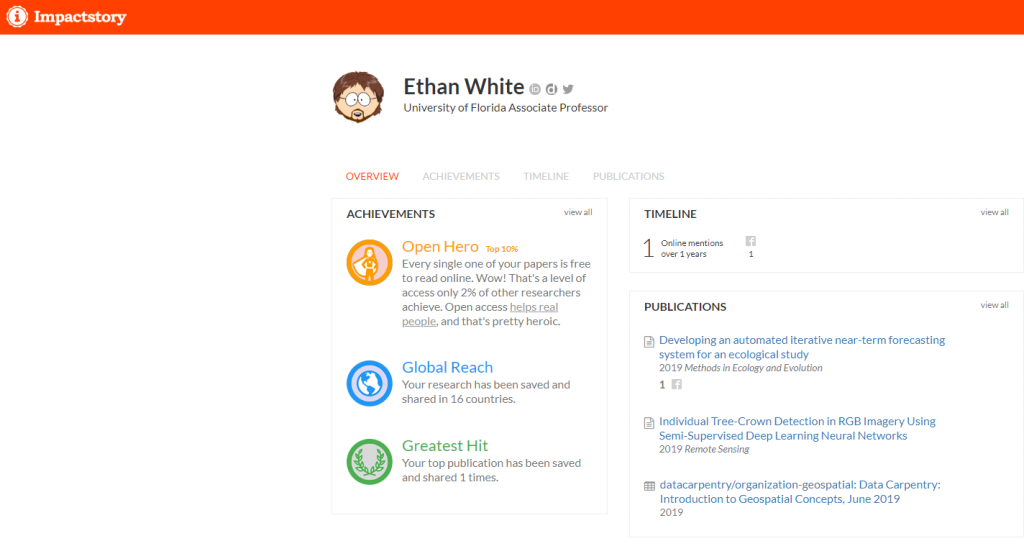Definition: Social media metrics (popularly known as altmetrics) refers to the metrics (number of tweets, Facebook counts, Wikipedia mentions, blog posts, news mentions, and saves/readers in online reference management tools) for research products driven from social media platforms.
History: The idea for measuring social media metrics of research outputs first introduced by Jason Priem in 2010 and followed by Altmetric Manifesto. Altmetric Manifesto calls for including real-time and diverse research products as well as diverse forms of interactions of different users with research products across various online platforms for tracking and measuring research impact in order to complement traditional scholarly impact analysis.
Importance: Social media metrics reflects how often, by whom, and when different research products are mentioned and discussed across social media platforms. These metrics provide divers and real-time impact by different users (such as researchers, general public, practitioners, etc.) who have interacted with research products in social media platforms.
Data providers/aggregators: The main social media metrics data providers/ aggregators include: Altmetric.com, Plum Analytics, CrossRef Data Event, Impact Story, and Lagotto. These providers/aggregators differ in terms of data sources and research products they track and their different approaches in collecting, aggregating, and reporting social media metrics. Interested to know more, read this open access article. This chapter also provides a general overview of Social media metrics and its applications.

Altmetric.com is a Digital Science company founded in 2011. A range of different sources including mentions of research outputs in policy documents, blogs, mainstream media, online reference managers, and social media tools are tracked by Altmetric.com based on URLs or unique identifiers of research outputs. Metrics of research outputs displayed via a detailed page and Altmetric Donut.
In order to add Altmetric Donut to your browser follow these steps:
1.Go to: https://www.altmetric.com/products/free-tools/bookmarklet/

2. Drag and drop Altmetric it to your browser.

3. Open an article in your browser and then click Altmetric it.
In case the article is tracked by Altmetric.com, Altmetric donut will appear and displays social media metrics of the paper if there is any as shown below:

4. Click for more details to see more info: https://www.altmetric.com/details/2193551?src=bookmarklet
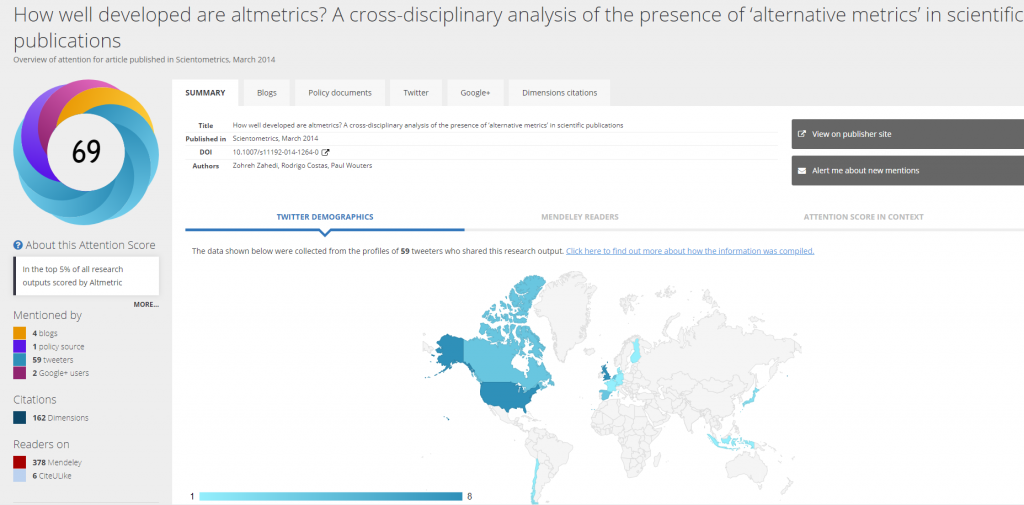
Alternatively, add a DOI of a paper (10.1007/s11192-014-1264-0) to this URL (http://www.altmetric.com/details/php?doi=) to see more details as shown here: http://www.altmetric.com/details/php?doi=10.1007/s11192-014-1264-0
5. It is possible to set the notification Alert me about new mentions in order to get an e-mail when a research output is mentioned across any social media platforms that are covered by Altmetric.com. It is possible to cancel the notification an any time.
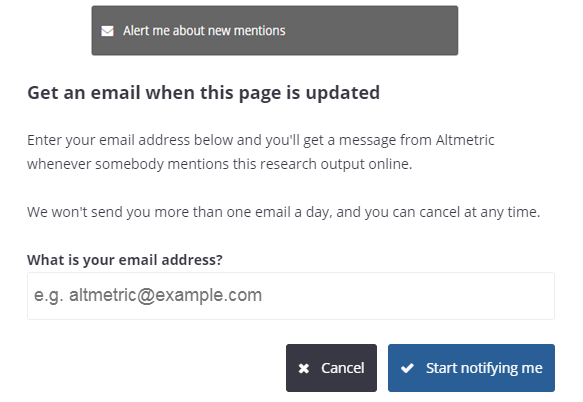
If you are interested to know more about which sources are tracked by Altmetric.com and how Altmetric Attention Score is calculated visit here & here.
For individual academic institutions Altmetric Donut Badge are free to display on content published by their institutes (see here an introductory video).
Follow these steps:
- Inform Altmetric.com the domain of your institutional repository/ research portal. For this you need to send an email to: support@altmetric.com
- Choose the style of badge you’d like to be shown on your institutional repository/research portal.
- Go to altmetric.com/badges and add the code and the badges to the web page of your institute. The badge can be customized (as data-badge type, data-badge popover, or data-badge details, etc.) by adding some attributes. Visit here for more info.
Clicking the badge leads to the detailed page on Altmetric.com that contains social media metrics of research outputs. For more information visit this page.
Note: It is very important to make sure that the research outputs of your institute have Unique identifiers such as DOI, PubMed ID, arXiv ID, Handle, ISBN, etc. to be tracked by Altmetric.com. See here for the list of identifiers tracked by Altmetric.com.
Altmetric.com offers free individual access to a basic version of the Altmetric Explorer for academic librarians. This option provides librarians an opportunity to browse and filter research outputs in Altmetric.com database and to get an idea of how does Altmetric explorer for an institution look like. For more info visit this page. For request for having an account send an e-mail to: info@altmetric.com
Plum Analytics founded in 2012, acquired by Ebsco in 2014 and by Elsevier in 2017. It provides metrics for different research outputs (articles, blog posts, books, source codes, theses/dissertations, videos). The metrics are grouped in 5 categories of usage, captures, mentions, social media, and citations.
In order to track PlumX metrics of your research output follow these steps:
1. Add the DOI or PubMed ID of research output to this link https://plu.mx/plum/a/ as shown below:
https://plu.mx/plum/a/?doi=10.1371/journal.pone.0197326
https://plu.mx/plum/a/?pmid=29772003
2. Click enter. PlumX metrics of the research output will be displayed as:
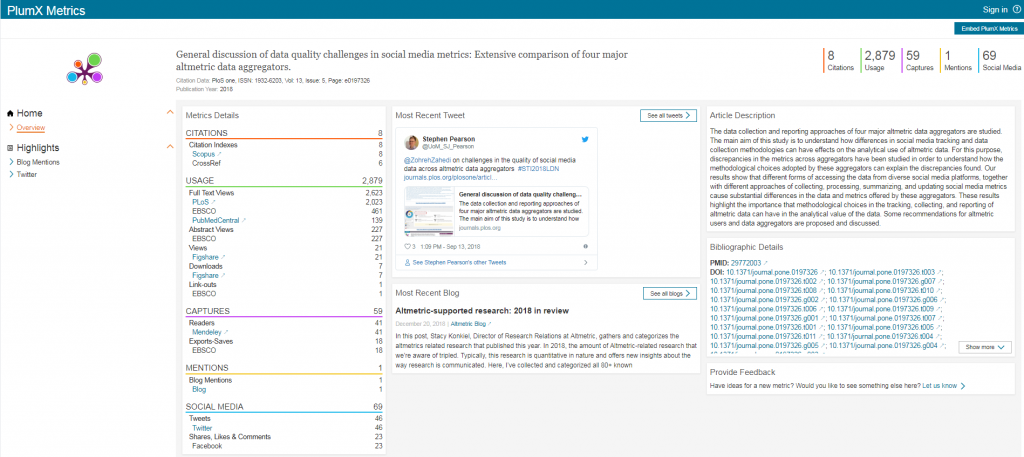
PlumX metrics are integrated on some platforms (such as Mendeley, SSRN, Scopus, Science Direct, Ebsco, Engineering village, etc.). There is also an option in Pure (5.14) to enable PlumX Metrics widget for research output that has DOI/Scopus ID. If a publication in Pure does not have these identifiers, PlumX metrics will not be displayed.
If you are interested to know more about PlumX metrics (how the metrics are calculated and which research outputs and social media sources are tracked) visit this page.

- Go to this page.
- Insert identifier (DOI, PubMed ID, Scopus ID, etc.) of research output.
- Click Get the code button.
- Copy and paste the code on your web page where you want the widget to appear. for more info, visit: https://plu.mx/developers/widgets/
PlumX widget for repositories/research portal: Plum Analytics offers PlumX metrics and widget free of charge to repositories and open access journals upon request and approval. For this send an e-mail to: support@plumanalytics.com
Lagotto is a social media metrics data aggregator. It is an Open Source application started in 2009 by Public Library of Science (PLOS). Lagotto provides social media metrics both for PloS articles (known as PLOS ALM) and also for articles from any other publishers. It retrieves data from a wide set of sources. The metrics are grouped in different categories of impact (viewed, saved, discussed, recommended, and cited).

It is possible to make social media metrics reports for any set of PLOS articles with DOIs or PMIDs using simple/advanced search query or by uploading a file of (max 500) articles that contains DOIs or PMIDs one per line (See here for an example of such a file). For articles from other publishers use Lagotto API to retrieve social media metrics aggregated by lagotto. For more info visit: https://www.lagotto.io/
CrossRef Event Data (ED) is a social media data aggregator started in April 2017 (beta version). ED collects raw social media data from a selection of sources such as Wikipedia, Twitter, Reddit, Stack Exchange Network, etc. for CrossRef registered contents. It doesn’t provide social media metrics but a stream of events (raw data) that occurred for a given piece of registered content with a DOI.
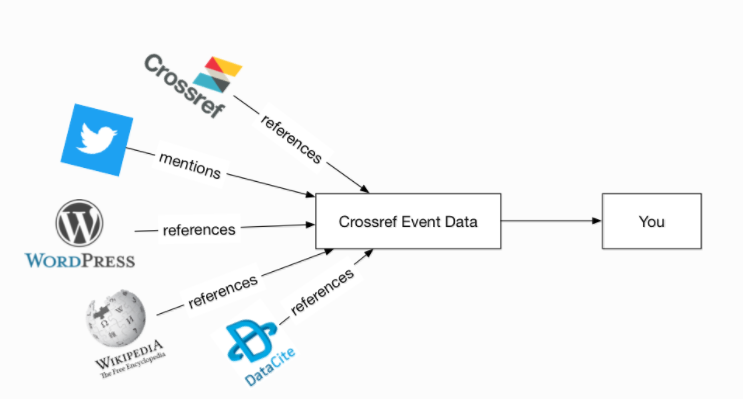
ED connects to some external data sources, turns the data into ‘events’ (bookmarks, comments, shares), and finally provides provenance, context, and links for each event. An example of an event (raw tweet data for a paper) is shown below:
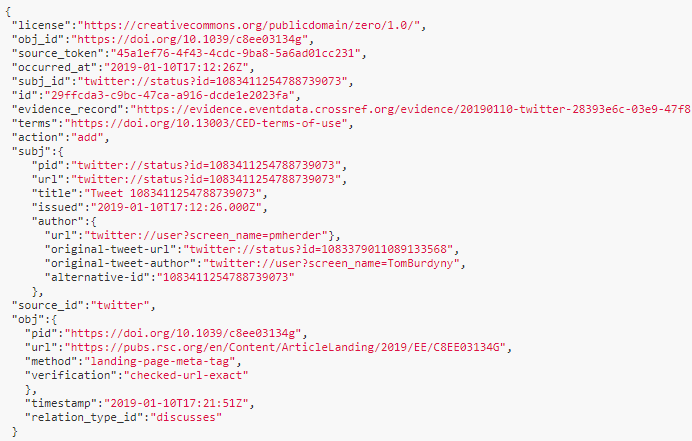
The resulted events are publically available via an open Event Data API. It is possible to use this API to retrieve raw social media data. For more information visit: https://www.eventdata.crossref.org/guide/

Impact Story is an open-source tool founded in 2011 by Jason Priem and Heather Piwowar. It provides social media metrics for diverse research outputs (such as articles, blog posts, datasets, and software) from Altmetric.com, Twitter, Mendeley, CrossRef, BASE, ORCID, etc. Impact Story offers a free online profile for researchers. It provides an overview of social media metrics and achievements (including the volume of discussions, openness, and global reach) of research outputs. An example of Impact Story researcher’s profile shown below:
Impact Story imports research outputs from ORCID. It is important for researchers to have an updated and public ORCID profile in order to be tracked by Impact Story. If interested to link your ORCID profile with Impact Story, follow these instructions here.

It is good to know that:
- Social media data aggregators differ in terms of metrics they offer, data sources they cover, and research products they track, and also the methods they calculate metrics.
- In order to know which aggregator to use, first think in which specific data source (Twitter, Facebook, Wikipedia, etc.) you are interested to track mention of research outputs; then check which aggregator cover that specific data source; and finally it is good to know how the metrics (for instance number of tweets vs. number of Twitter users) is calculated by that aggregator.
- Adding Altmetric.it bookmarklet to internet browser enables researchers to see Altmetric Attention Scores of the article that they have opened in their browser.
- Setting Alert me about new mentions (from altmetric detailed page) enables to get an e-mail when the research output is mentioned across social media platforms that are covered by Altmetric.com.
- PlumX metrics are available for research outputs in Pure 5.14.
- It is very important to emphasize that social media metrics are mostly available for research outputs that have digital identifiers (such as DOI, PubMed ID, etc.). Research outputs without digital identifiers are not tracked by social media metrics data aggregators.
| Social media metrics data aggregators | For researchers | For institutes | For web developers/ programmers | Access |
|---|---|---|---|---|
| Altmetric.com Plum Analytics | Altmetric Donut /PlumX metrics enable researchers to track outreach of their research outputs in the covered social media platforms. | Altmetric Explorer/PlumX metrics for institutes (subscription-based) enable to track and summarize outreach of research outputs of an organization. | Altmetric Donut Badge/ PlumX Metrics Widget enable web developers to embed the badge/widget on the website or research portal in order to display the outreach of research outputs of an organization. | offer free tools for academics and subscription-based services for institutes. |
| Lagotto/PloS ALM CrossRef Event Data | Lagotto/PloS ALM article level metrics or raw social media data from CrossRef enable researchers to track outreach of their research outputs in the covered social media platforms. | enable institutes to make an article level metrics report of their outputs published in PloS journals using the dedicated website or for other publishers using Lagotto API. | There is no widget or badge. Web developers could use open source application to extract social media data to display on their web sites. | Lagotto open source application and CrossRef open Event Data API enable to retrieve social media data. |
| Impact Story | free online profile for researchers including social media metrics for their research outputs from the covered social media platforms. | enables institutes to track researcher’s profiles and social media impact of their research outputs. | There is no widget or badge. | offers open API and open source codes. |
Metrics Literacy
Maddie Hare, Heather Woods, Isabelle Dorsch, Carey Ming-Li Chen, and Stefanie Haustein. Developing Metrics Literacies: Competencies, dispositions, and knowledge for the critical assessment and ethical use of scholarly metrics. The Bibliomagician blog. 6 December 2023.
The authors discuss their groundbreaking work on the Metrics Literacies Project. The Metrics Literacies project is informed by this concept: ‘an integrated set of competencies, dispositions and knowledge that empowers individuals to recognize, interpret, critically assess and effectively and ethically use scholarly metrics,’ which is guided by the overarching question, ‘How can the understanding and use of scholarly metrics in academia be improved?’

